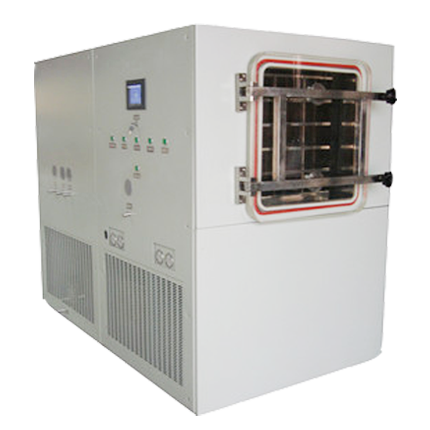
Commercial vacuum freeze dryer Application of freeze dryer machine:
Vacuum freeze-drying technology is applied to process food products to make freeze dried food with top drying quality.
Fruits: apple,durian, banana,strawberry, mango, apricot, kiwifruit, pineapple, lemon, raspberry, avocado, date, etc.
Vegetables: broccoli,mushroom, bean, scallion, asparagus, onion, celery, carrot, tomato, pepper etc.
Other food: beef, coffee, milk, herbal, flower, tea, honey, sea food ,pets food, etc.
Remarkable advantage of freeze-dried food:
1. Retain biological activity as much as possible
2. No loss or damage to the nutrition
3. Remain same color, taste and appearance
4.Longer shelf-life than frozen food, canned food and oven drying food.
5.Help us have a more healthy lifestyle.
Working principle:
After pre-freezing treatment,inner moisture of the food will be sublimated with heating measures under
vacuum control, so the food is dried with good quality.
The whole processing line including the following systems:
1. pre-freezing room 2. drying chamber 3. heating system 4. vacuum system
5. refrigeration system 6. material transport 7. control system 8.Circulation system
Technical Parameter :

we can supply Freeze dryer machines:
1. Large scaled production capacity: from 10kg -2500kg per batch
2. Equipments with certificates of ISO, CE .
3. International brand parts, user can also choose best local brand parts as option to save cost.
4. 220V/380V/50Hz is the standard configuration; 110/120/ 60Hz, 400/480V/60Hz optional.
5.We provide Individual Quick Freezing room as a standard configuration from LG-10 to LG-100 for radiant
type of freeze dryer machine.
6.Steam or electricity is optional for material heating to save your energy cost.
7.Alternate vapor trap as an option. Double vapor traps are installed under the heating plates in drying chamber. Trap 1 condenses water vapor to its maximum working cpacity, then trap 2 starts to condense. In the meantime,trap 1 begins to melt ice for another condensation cycle with continous defrosting. When the trap 2 reaches its maximum working cpacity, it begins ice defrosting . Meantime, the trap 1 begins to condense water vapor on coils during drying process.
8.Energy saving technology , the power consumption of products is less than traditional way 10-30%
9. We provide recyclable hot-water defrost system to improve the working efficiency and save energy cost.
10.We provide all-in-one freeze dryer machine to shorten installation time to 2-3 days for small-scaled freeze dryer machine; and meanwhile we can provide modularized units to shorten installation time for large-scaled freeze dryer machine. The freeze dryer machine will be designed according to customer's detai requirements.
11.Our engineers provide the installation,commissioning and technical training at user site.


The lyophilization process consists of first freezing the product to a temperature at which all formulation components form a rigid solid. This is followed by primary drying, in which up to 95% of the frozen water or ice is removed. During primary drying, controlled temperature shelves are utilized to provide the energy for sublimation of the ice. In turn, the pressure in the chamber must also be controlled in a way that heat can be added to the product to facilitate sublimation of the water, without causing melting or instability of the already dried product matrix. The sublimated water vapor from the product travels into the product chamber, and is transferred to the condenser due to the pressure differential between the product chamber and the condenser; it is then frozen onto the coils or plates in the condenser, thus helping the condenser to remain in a low pressure condition relative to the product chamber (1). Any remaining water not removed during primary drying is removed during a secondary, desorption drying step.
Critical parameters in developing a lyophilization cycle – and thus successful freeze-drying – include knowing the collapse temperature of the formulation, the stability of the active pharmaceutical ingredient and the properties of the excipients (2). In addition to properties of the formulation, shelf temperature, chamber pressure, system geometry and the product container all play major roles in lyophilization cycle development. Many lyophilization processes are developed in a ‘trial-and-error’ manner that often results in non-optimized lyophilization cycles that may not transfer well from the laboratory to production scale-up.
The conventional method for measuring product temperature during a freeze-drying cycle is to place a few selected temperature sensors in vials. Note, however, that this may affect the freezing and drying behaviour of the samples by inducing ice nucleation or acting as a thermal pathway. These issues make placing a thermocouple in a vial a poor representation for what is actually occurring in the majority of vials present in the product chamber. In addition, temperature sensors or thermocouples placed in vials are located towards the bottom of the vial – not at the sublimation interface – and therefore do not give an accurate a measurement of product temperature at the sublimation-ice interface (1). Thermocouples are sometimes difficult to repeatedly place in the same position, and have their own inherent inaccuracies across their temperature range.
